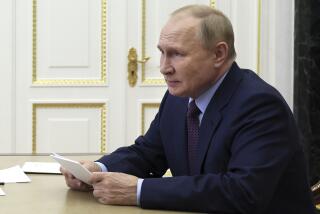‘Dirty Tricks’ by Moscow an Old Story to Diplomats
- Share via
WASHINGTON — The Soviet Union, accused Wednesday of using a chemical powder to help spy on U.S. diplomats in Moscow, long has employed “dirty tricks” to keep tabs on diplomats’ communications and activities.
To a considerable extent, all players in the espionage game use various bugging and tracking techniques. But the Soviets tend to get caught more frequently, experts say--perhaps because they are often more brazen about their spying.
The most famous Soviet maneuver was the implantation of a listening device in a carved replica of the Great Seal of the United States, which hung in the U.S. Embassy in Moscow from 1945 to 1952 before the electronic bug was discovered.
The late Henry Cabot Lodge, when he was U.S. ambassador to the United Nations, displayed the bugged seal at a dramatic U.N. session 25 years ago. He charged that more than 100 such listening devices have been found in U.S. embassies, missions and residences in the Soviet Union and its satellite nations.
Microwave Bombardment
In another well-publicized example, the Soviets for many years bombarded the U.S. Embassy in Moscow with microwaves, apparently either to activate listening devices or to jam U.S. electronic intelligence-gathering equipment.
The microwave assault was first detected in the 1960s and reached peak intensity in 1975 and 1976 before it was ended in 1978. However, it resumed sometime later and was detected two years ago, when U.S. officials issued a strong protest. The microwaves did not pose a health hazard, they said, but were objectionable as a “matter of principle.”
The Soviets also have been widely reported to use their embassy buildings in Washington and the consulate in San Francisco for intercepting telephone and data communications carried by microwaves, an extremely high-frequency form of radio waves. Computers can sort out recorded signals and listen to calls from specified telephone numbers.
Only last March, the Soviets were accused of having used sensing devices capable of picking up what was written on typewriters at the U.S. Embassy in Moscow. The bugging, which lasted at least a year, ended after being discovered in 1984.
Besides such clandestine ploys, the Soviets openly use coded automobile license plates to help keep track of U.S. diplomats and journalists in Moscow. By the same token, the State Department uses coded license plates for all foreign diplomats here, the Washington Post reported recently.
More to Read
Sign up for Essential California
The most important California stories and recommendations in your inbox every morning.
You may occasionally receive promotional content from the Los Angeles Times.













